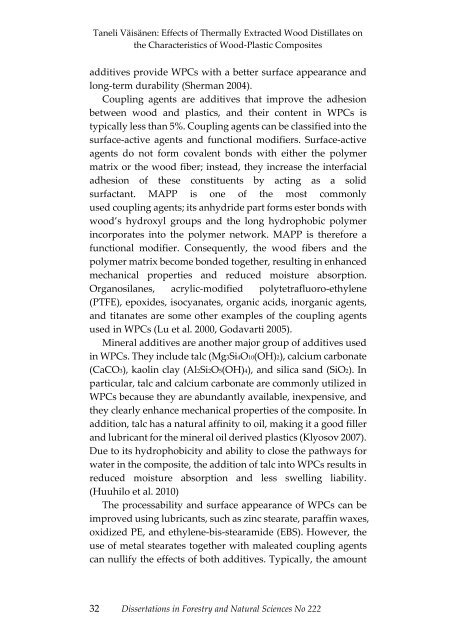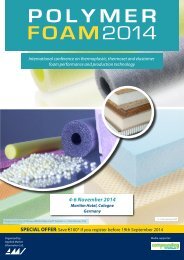Dissertations in Forestry and Natural Sciences
24lYKFN
24lYKFN
Create successful ePaper yourself
Turn your PDF publications into a flip-book with our unique Google optimized e-Paper software.
Taneli Väisänen: Effects of Thermally Extracted Wood Distillates on<br />
the Characteristics of Wood-Plastic Composites<br />
additives provide WPCs with a better surface appearance <strong>and</strong><br />
long-term durability (Sherman 2004).<br />
Coupl<strong>in</strong>g agents are additives that improve the adhesion<br />
between wood <strong>and</strong> plastics, <strong>and</strong> their content <strong>in</strong> WPCs is<br />
typically less than 5%. Coupl<strong>in</strong>g agents can be classified <strong>in</strong>to the<br />
surface-active agents <strong>and</strong> functional modifiers. Surface-active<br />
agents do not form covalent bonds with either the polymer<br />
matrix or the wood fiber; <strong>in</strong>stead, they <strong>in</strong>crease the <strong>in</strong>terfacial<br />
adhesion of these constituents by act<strong>in</strong>g as a solid<br />
surfactant. MAPP is one of the most commonly<br />
used coupl<strong>in</strong>g agents; its anhydride part forms ester bonds with<br />
wood’s hydroxyl groups <strong>and</strong> the long hydrophobic polymer<br />
<strong>in</strong>corporates <strong>in</strong>to the polymer network. MAPP is therefore a<br />
functional modifier. Consequently, the wood fibers <strong>and</strong> the<br />
polymer matrix become bonded together, result<strong>in</strong>g <strong>in</strong> enhanced<br />
mechanical properties <strong>and</strong> reduced moisture absorption.<br />
Organosilanes, acrylic-modified polytetrafluoro-ethylene<br />
(PTFE), epoxides, isocyanates, organic acids, <strong>in</strong>organic agents,<br />
<strong>and</strong> titanates are some other examples of the coupl<strong>in</strong>g agents<br />
used <strong>in</strong> WPCs (Lu et al. 2000, Godavarti 2005).<br />
M<strong>in</strong>eral additives are another major group of additives used<br />
<strong>in</strong> WPCs. They <strong>in</strong>clude talc (Mg3Si4O10(OH)2), calcium carbonate<br />
(CaCO3), kaol<strong>in</strong> clay (Al2Si2O5(OH)4), <strong>and</strong> silica s<strong>and</strong> (SiO2). In<br />
particular, talc <strong>and</strong> calcium carbonate are commonly utilized <strong>in</strong><br />
WPCs because they are abundantly available, <strong>in</strong>expensive, <strong>and</strong><br />
they clearly enhance mechanical properties of the composite. In<br />
addition, talc has a natural aff<strong>in</strong>ity to oil, mak<strong>in</strong>g it a good filler<br />
<strong>and</strong> lubricant for the m<strong>in</strong>eral oil derived plastics (Klyosov 2007).<br />
Due to its hydrophobicity <strong>and</strong> ability to close the pathways for<br />
water <strong>in</strong> the composite, the addition of talc <strong>in</strong>to WPCs results <strong>in</strong><br />
reduced moisture absorption <strong>and</strong> less swell<strong>in</strong>g liability.<br />
(Huuhilo et al. 2010)<br />
The processability <strong>and</strong> surface appearance of WPCs can be<br />
improved us<strong>in</strong>g lubricants, such as z<strong>in</strong>c stearate, paraff<strong>in</strong> waxes,<br />
oxidized PE, <strong>and</strong> ethylene-bis-stearamide (EBS). However, the<br />
use of metal stearates together with maleated coupl<strong>in</strong>g agents<br />
can nullify the effects of both additives. Typically, the amount<br />
32 <strong>Dissertations</strong> <strong>in</strong> <strong>Forestry</strong> <strong>and</strong> <strong>Natural</strong> <strong>Sciences</strong> No 222



